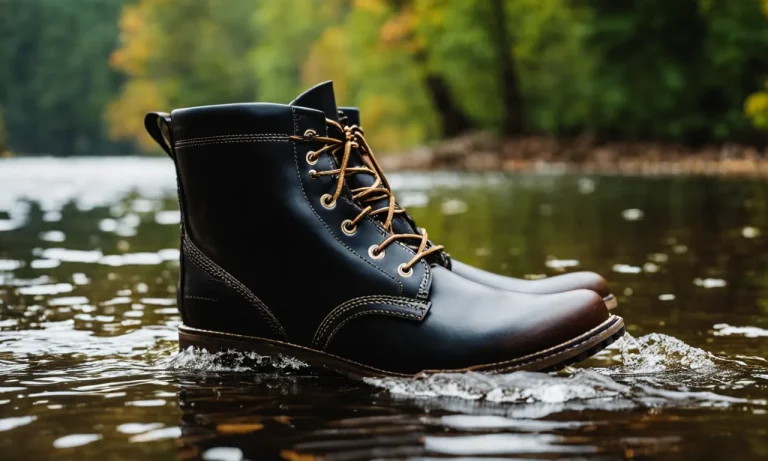During the winter months, many pet owners wonder if their dogs need extra protection from the cold and snow in the form of booties or paw wax. If you’ve asked yourself “do dogs need snow boots?”, you’re not alone!
If you’re short on time, here’s a quick answer to your question: Most dogs don’t necessarily need snow boots, but they can be useful in certain situations for protecting paws from ice, salt, and extremely cold temperatures.
Factors like breed, fur thickness, time spent outdoors, and pavement conditions should be considered.
In this comprehensive guide, we’ll cover everything you need to know about dogs and snow boots. We’ll look at the pros and cons, examine factors that may indicate your dog could benefit from booties, provide tips for selecting the right snow boots, and give recommendations for helping pups adjust to wearing them.
Pros and Cons of Dog Snow Boots
Benefits of Dog Snow Boots
Dog snow boots can be a great investment for pet owners during the winter months. Here are some of the benefits:
- Protection from cold and ice: Snow boots provide a layer of insulation and protection for your dog’s paws, keeping them warm and preventing frostbite. They also help to keep ice and snow from accumulating between the toes, which can be uncomfortable or even painful for your furry friend.
- Prevention of injuries: Snow boots can help prevent injuries such as cuts, scrapes, and bruises that can occur when walking on rough or icy terrain. The boots provide a barrier between your dog’s paws and any sharp objects or debris that may be hidden in the snow.
- Better traction: Dog snow boots usually have non-slip soles that provide better traction on slippery surfaces. This can help your dog maintain stability and prevent slips and falls, especially on icy sidewalks or driveways.
- Easy to clean: Most dog snow boots are designed to be easy to clean. You can simply wipe off any dirt or snow that gets trapped in the boots, keeping your dog’s paws clean and dry.
Potential Downsides of Dog Snow Boots
While dog snow boots offer several benefits, there are also some potential downsides to consider:
- Getting used to wearing them: Some dogs may initially find it uncomfortable or strange to wear snow boots. It may take time and patience to get your dog accustomed to wearing them, especially if they have never worn any type of footwear before.
- Proper fit: It’s important to choose the right size and fit for your dog’s snow boots. If the boots are too tight, they can cause discomfort and restrict blood flow to the paws. On the other hand, if the boots are too loose, they may slip off easily.
- Cost: Good quality dog snow boots can be quite expensive, especially if you opt for durable and long-lasting ones. You may need to consider your budget before investing in a pair.
- Maintenance: Dog snow boots require regular maintenance to ensure they remain in good condition. This may include cleaning, drying, and inspecting for any damage or wear and tear.
It’s important to weigh the pros and cons of dog snow boots and consider your dog’s individual needs and preferences. If you live in an area with harsh winter conditions or frequently go on outdoor adventures with your furry companion, snow boots may be a worthwhile investment to protect and keep your dog comfortable during the colder months.
Factors to Consider About Your Dog and Environment
When it comes to deciding whether or not your dog needs snow boots, there are several factors that you should take into consideration. These factors include the breed and coat thickness of your dog, the amount of time your dog spends outdoors, the sensitivity of their paws, and the conditions of the pavement they will be walking on.
Breed and Coat Thickness
Some dog breeds have thicker coats and are better equipped to handle colder temperatures and snowy conditions. Breeds such as Huskies, Malamutes, and Saint Bernards have a natural ability to withstand cold weather due to their thick fur and insulating undercoats.
On the other hand, breeds with shorter hair, such as Chihuahuas or Greyhounds, may benefit from wearing snow boots to keep their paws warm and protected.
Time Spent Outdoors
Consider how much time your dog spends outdoors. If they are only outside for short periods to do their business, they may not require snow boots. However, if your dog enjoys long walks or outdoor activities in the snow, boots can provide them with added protection against frostbite, ice, and salt on the pavement.
Paw Sensitivity
Some dogs have more sensitive paws than others. Breeds with delicate or sensitive paws, such as Poodles or Bulldogs, may be more prone to discomfort from walking on snow, ice, or salt. Snow boots can help prevent irritation, cuts, and cracking of their paw pads, providing them with a more comfortable winter experience.
Pavement Conditions
The condition of the pavement your dog will be walking on is an important factor to consider. In areas where salt or chemical de-icers are commonly used to melt ice, the pavement can become harsh and abrasive, causing damage to your dog’s paws.
Snow boots can act as a barrier between their paws and the pavement, reducing the risk of injury or irritation. Furthermore, boots can also prevent your dog from ingesting harmful chemicals when they lick their paws.
Remember, each dog is different, and what works for one may not work for another. It’s essential to assess your dog’s individual needs and consult with a veterinarian if you have any concerns. Additionally, if you decide to invest in snow boots for your dog, make sure to choose ones that fit properly and provide the necessary protection without causing discomfort.
Choosing the Right Dog Snow Boots
Measurement and Sizing
When it comes to choosing the right snow boots for your furry friend, one of the most important factors to consider is measurement and sizing. Just like humans, dogs come in different shapes and sizes, so it’s essential to find boots that fit them properly.
Measure your dog’s paw size by placing their paw on a piece of paper and tracing around it. Use these measurements to find the right size of boots for your dog. Remember, a snug fit is necessary to ensure that the boots stay on securely without being too tight or uncomfortable.
Materials and Design
The materials and design of dog snow boots play a crucial role in their effectiveness. Look for boots that are made of durable and waterproof materials like neoprene or nylon. These materials will protect your dog’s paws from cold, wet, and icy conditions.
Additionally, consider boots with a non-slip sole to provide traction on slippery surfaces. Some boots also have reflective strips, which can be beneficial during nighttime walks.
Amount of Coverage
The amount of coverage offered by the snow boots is another important aspect to consider. Ideally, the boots should cover the entire paw, including the pads and the area between the toes. This will not only keep your dog’s paws warm and dry but also protect them from ice, rocks, and other sharp objects.
Boots with adjustable cuffs can provide a snug fit and prevent snow from entering the boots.
Fastening System
The fastening system of the snow boots is crucial for keeping them securely in place. Look for boots with a reliable and adjustable fastening system, such as Velcro straps or buckles. These will allow you to adjust the boots to your dog’s paw size and ensure a snug fit.
It’s also important to choose boots that are easy to put on and take off, as this will make the overall experience more comfortable for both you and your dog.
Remember, not all dogs may need snow boots. Some breeds are naturally equipped to handle cold weather, while others may have sensitive paws that require extra protection. Consult with your veterinarian to determine if your dog would benefit from wearing snow boots, especially if you live in an area with harsh winter conditions.
Helping Your Dog Adjust to Wearing Boots
Introduce Slowly with Positive Reinforcement
Getting your dog to wear snow boots can be a new and potentially strange experience for them. It’s important to introduce the boots slowly and positively to help them adjust. Start by showing them the boots and rewarding them with treats and praise for showing interest.
Gradually, try putting the boots on their paws for short periods of time, always reinforcing the positive with treats and encouragement. This process may take some time, but with patience and consistency, your dog will become more comfortable with wearing boots.
Start Indoors First
When first introducing your dog to snow boots, it’s a good idea to start indoors. This controlled environment allows them to get used to the sensation of wearing the boots without the added distraction of cold weather or unfamiliar surroundings.
Begin by having your dog wear the boots for short periods of time inside the house, gradually increasing the duration as they become more comfortable. This will help them associate the boots with positive experiences and build their confidence.
Check for Proper Fit
Ensuring that the boots fit properly is crucial for your dog’s comfort and safety. Ill-fitting boots can cause discomfort, chafing, or even injuries. To determine the right size, measure your dog’s paws and refer to the manufacturer’s sizing guide.
Keep in mind that different brands may have slightly different sizing, so it’s important to measure each time you purchase new boots. Additionally, check that the boots are snug but not too tight, allowing for proper circulation.
Regularly inspect the boots for any signs of wear and tear, and replace them as needed.
Be Patient During the Transition
Transitioning your dog to wearing snow boots may not happen overnight. Some dogs may take longer to adjust than others. It’s important to be patient and understanding during this process. Remember to provide positive reinforcement and rewards for your dog’s progress, and never force the boots on them if they show signs of distress or discomfort.
With time and persistence, your dog will become accustomed to wearing boots and will be ready to brave the snowy outdoors in style.
Other Paw Protection Tips
Musher’s Secret Paw Wax
Another option to protect your dog’s paws from snow and ice is to use Musher’s Secret Paw Wax. This all-natural wax forms a barrier between your dog’s paws and the elements. It helps to prevent ice and snow from sticking to your dog’s fur, reducing the chance of ice balls forming between the toes.
The wax also provides a layer of protection against salt and other chemicals that can irritate your dog’s paws. Applying Musher’s Secret Paw Wax before going for a walk can greatly reduce the discomfort your dog may experience from cold weather and harsh conditions.
Keep Fur Around Paw Pads Trimmed
Trimming the fur around your dog’s paw pads can help prevent ice and snow from accumulating and forming ice balls. Ice balls can be painful and cause discomfort for your furry friend. By keeping the fur trimmed, you can minimize the risk of these painful ice balls forming and ensure that your dog’s paws stay warm and dry during winter walks.
Moisturize Paws
Just like our skin can become dry and cracked during the winter months, so can your dog’s paws. To keep your dog’s paws healthy and moisturized, consider using a pet-safe paw balm or moisturizer. These products can help prevent dryness, cracking, and irritation caused by cold and dry conditions.
Regularly applying a paw moisturizer can make a significant difference in the comfort and well-being of your dog’s paws.
Wipe Paws After Walks
After your dog’s winter walks, it’s important to wipe their paws to remove any snow, ice, or chemicals they may have come into contact with. This will not only help keep your home clean but also prevent your dog from ingesting any harmful substances when they lick their paws.
Use a warm damp cloth or pet-friendly wipes to gently clean your dog’s paws, paying close attention to the areas between the toes. By taking this simple step, you can help prevent discomfort and potential health issues for your dog.
Remember, while snow boots can provide excellent protection for your dog’s paws in winter, there are other measures you can take to keep their paws safe and comfortable. Whether you choose to use paw wax, trim their fur, moisturize their paws, or wipe their paws after walks, these additional paw protection tips can greatly enhance your dog’s winter experience.
Conclusion
To summarize, while snow boots aren’t essential for all dogs, they can be extremely useful for protecting paws in icy winter conditions. Consider your dog’s breed, coat, time outdoors, and paw sensitivity when deciding if booties could benefit them.
Choose well-fitting, durable boots and take time to positively reinforce wearing them. With patience and the right introduction, you can help make your pup comfortable in their new winter accessories.
Providing paw protection will lead to more enjoyable winter walks and activities for you both. Just be sure to keep a close eye on your dog when trying booties for the first time and don’t force them to wear something they aren’t comfortable with yet.
With some training and the right boots, cold weather excursions with your furry friend can stay fun all winter long!






